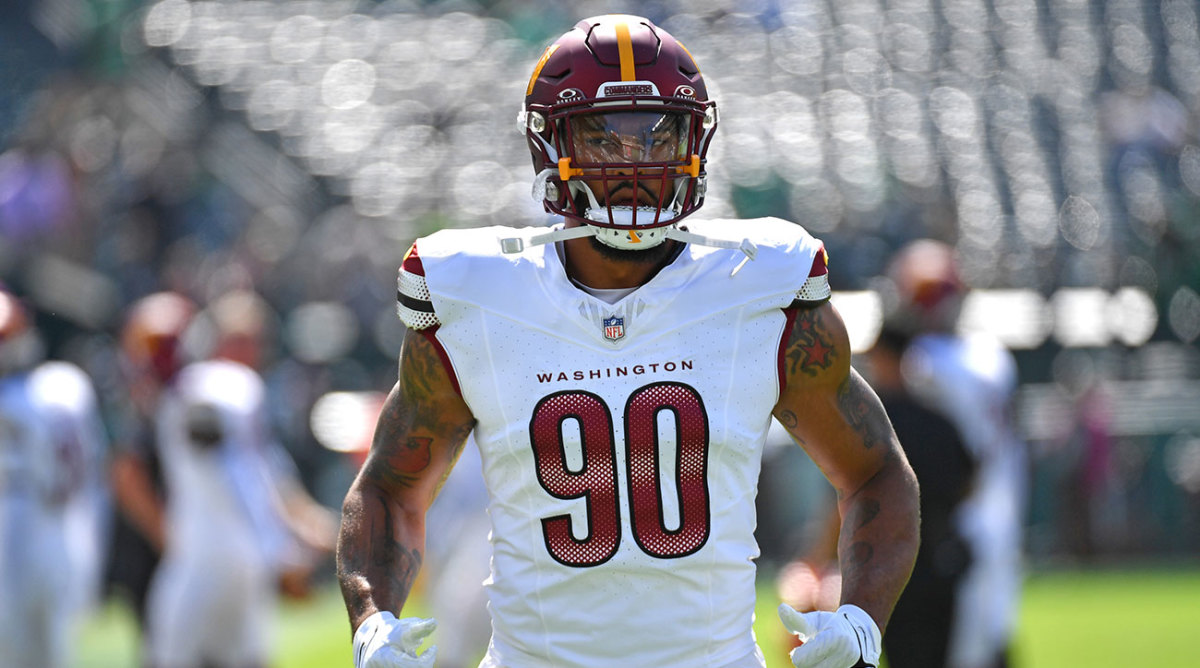Defending the Bears’ Curious Decision to Trade for Montez Sweat

The Bears’ trading of the No. 1 pick in the 2023 draft has been a little like a recreational drug with a few side effects. First came the euphoria after they were able to confidently double down on an ascending Justin Fields while he was still on his rookie deal, supply him with DJ Moore and transfer to the Panthers the unenviable task of picking the quarterback out of the haystack.
Then came the headaches, as Fields went through a bit of a regression, the Bears’ offensive line was gutted by injury and a handful of players Chicago could have selected at quarterback (C.J. Stroud and Anthony Richardson) began the season with promise.
Now, we’ve reached a sort of mellow stage of levelheadedness, where having traded the No. 1 pick makes some sense again. Chicago was able to land Commanders pass rusher Montez Sweat before Tuesday’s deadline for a second-round pick. While the move seems egregious at first glance—namely, why on Earth would this team be trading real capital for a player at the end of his contract amid a lost season—it is sensible specifically because of the flexibility the team has created for itself. It is now up to you, the consumer, to wonder whether the assets are being directed in the right way.

Ultimately, the Bears will have to get the coaching and quarterback spots right. My take is that, in the meantime, they have been winning more transactions than they’ve been losing, while leaving room for possible mistakes but not doubling down on them. That’s all a front office can really do.
Trading for Sweat made sense specifically because the Bears already have two first-round picks in the 2024 draft (their own and the Panthers’), which would both be in the top three in the current order. The Bears also have more than $110 million in available cap space, which means the available funding to absorb the long-term extension that Sweat will command. Sweat is in his athletic prime and, barring injury, will be more useful than a first-round pick in the ’24 season. Sweat’s acquisition will also allow the Bears to spend their first-round picks on other premium positions, as they bring in a player we already know is a good pro amid their lottery picks in the draft. The Bears will, at best, be in the fourth year of Fields’s rookie deal, or, at worst, in the first year of a top-three quarterback’s rookie deal, which will toll their salary cap roughly $7 million. So, the time to absorb these kinds of deals is now.
I have likened the situation Ryan Poles inherited with the Bears to what Joe Douglas took on when he became the general manager of the Jets. There was a cultural rebuild. There was a structural rebuild. It was larger in scope than we can possibly imagine. Through that process, there was a necessity to take some targeted risks when it came to veteran contracts, people who could raise the level of the team from uncompetitive to competitive faster. So, for every hit, there was a Carl Lawson. The Bears are hoping Sweat is their counterbalance to a failed Chase Claypool trade.
So long as the front office is taking these chances responsibly, there should be less consternation. The Jets grabbed Lawson at a time when the economics of available pass rushers were so beneficial for acquiring teams that it was almost negligent not to take a chance. The same could be said for acquiring Claypool following the great receiver boom of 2022. That year, executives were desperate for any receiver help that didn’t come via unfathomable inflation. Claypool, in that moment, was a risk worth taking.
Watch the NFL with Fubo. Start your free trial today.
That’s my thought, at least, which is why I’m willing to give the Sweat acquisition the benefit of the doubt. When a team underperforms, there is an idea that everything and anything touching the product is riddled with incompetence. For example, the Bears’ landing Tremaine Edmunds in free agency and still struggling defensively, even though they are currently third in the NFL in opponent EPA per rush (and almost dead last versus the pass). There seems like a restlessness around the Bears’ process while the 30,000-foot view doesn’t look so bad.
Back when the Jets were dealing with their Mekhi Becton and Zach Wilson hangover, there was no sense of the larger picture, which would soon include Sauce Gardner and Garrett Wilson. Chicago is priming its roster for that moment in 2024, with some of the most valuable draft equity we’ve seen in modern NFL history (at least as it stands right now). That seems like a pill worth swallowing.
